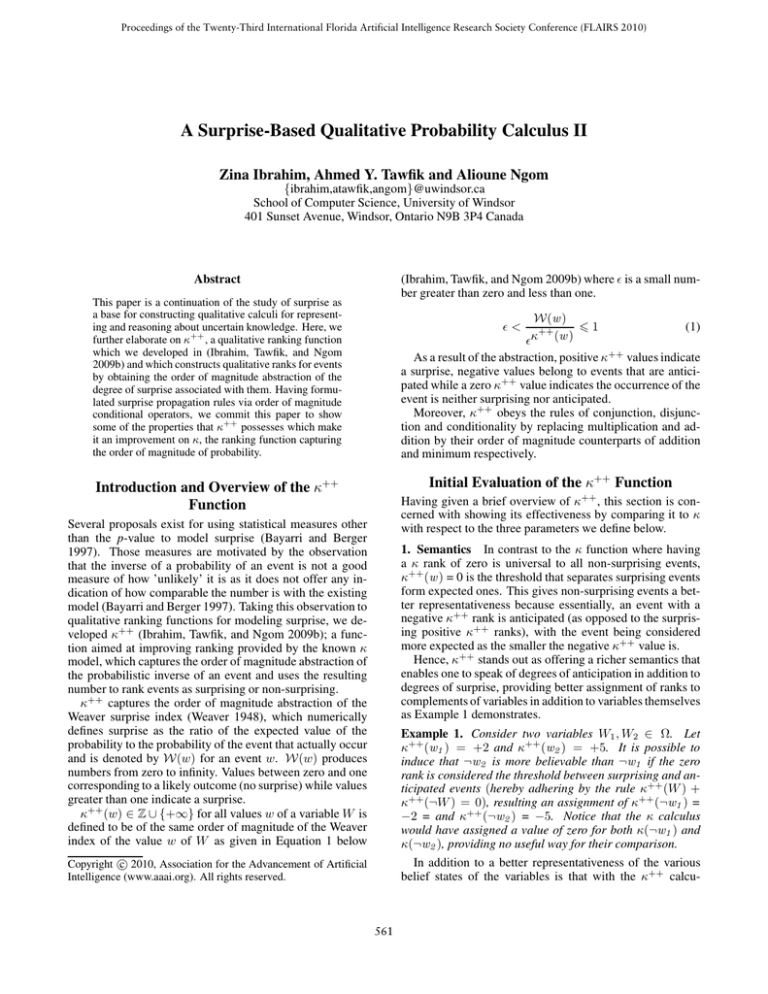A Surprise-Based Qualitative Probability Calculus II
advertisement

Proceedings of the Twenty-Third International Florida Artificial Intelligence Research Society Conference (FLAIRS 2010)
A Surprise-Based Qualitative Probability Calculus II
Zina Ibrahim, Ahmed Y. Tawfik and Alioune Ngom
{ibrahim,atawfik,angom}@uwindsor.ca
School of Computer Science, University of Windsor
401 Sunset Avenue, Windsor, Ontario N9B 3P4 Canada
(Ibrahim, Tawfik, and Ngom 2009b) where is a small number greater than zero and less than one.
Abstract
This paper is a continuation of the study of surprise as
a base for constructing qualitative calculi for representing and reasoning about uncertain knowledge. Here, we
further elaborate on κ++ , a qualitative ranking function
which we developed in (Ibrahim, Tawfik, and Ngom
2009b) and which constructs qualitative ranks for events
by obtaining the order of magnitude abstraction of the
degree of surprise associated with them. Having formulated surprise propagation rules via order of magnitude
conditional operators, we commit this paper to show
some of the properties that κ++ possesses which make
it an improvement on κ, the ranking function capturing
the order of magnitude of probability.
<
W(w )
1
++
(w )
κ
(1)
As a result of the abstraction, positive κ++ values indicate
a surprise, negative values belong to events that are anticipated while a zero κ++ value indicates the occurrence of the
event is neither surprising nor anticipated.
Moreover, κ++ obeys the rules of conjunction, disjunction and conditionality by replacing multiplication and addition by their order of magnitude counterparts of addition
and minimum respectively.
Initial Evaluation of the κ++ Function
Introduction and Overview of the κ++
Function
Having given a brief overview of κ++ , this section is concerned with showing its effectiveness by comparing it to κ
with respect to the three parameters we define below.
Several proposals exist for using statistical measures other
than the p-value to model surprise (Bayarri and Berger
1997). Those measures are motivated by the observation
that the inverse of a probability of an event is not a good
measure of how ’unlikely’ it is as it does not offer any indication of how comparable the number is with the existing
model (Bayarri and Berger 1997). Taking this observation to
qualitative ranking functions for modeling surprise, we developed κ++ (Ibrahim, Tawfik, and Ngom 2009b); a function aimed at improving ranking provided by the known κ
model, which captures the order of magnitude abstraction of
the probabilistic inverse of an event and uses the resulting
number to rank events as surprising or non-surprising.
κ++ captures the order of magnitude abstraction of the
Weaver surprise index (Weaver 1948), which numerically
defines surprise as the ratio of the expected value of the
probability to the probability of the event that actually occur
and is denoted by W(w) for an event w. W(w) produces
numbers from zero to infinity. Values between zero and one
corresponding to a likely outcome (no surprise) while values
greater than one indicate a surprise.
κ++ (w) ∈ Z ∪ {+∞} for all values w of a variable W is
defined to be of the same order of magnitude of the Weaver
index of the value w of W as given in Equation 1 below
Example 1. Consider two variables W1 , W2 ∈ Ω. Let
κ++ (w1 ) = +2 and κ++ (w2 ) = +5. It is possible to
induce that ¬w2 is more believable than ¬w1 if the zero
rank is considered the threshold between surprising and anticipated events (hereby adhering by the rule κ++ (W ) +
κ++ (¬W ) = 0), resulting an assignment of κ++ (¬w1 ) =
−2 = and κ++ (¬w2 ) = −5. Notice that the κ calculus
would have assigned a value of zero for both κ(¬w1 ) and
κ(¬w2 ), providing no useful way for their comparison.
c 2010, Association for the Advancement of Artificial
Copyright Intelligence (www.aaai.org). All rights reserved.
In addition to a better representativeness of the various
belief states of the variables is that with the κ++ calcu-
1. Semantics In contrast to the κ function where having
a κ rank of zero is universal to all non-surprising events,
κ++ (w ) = 0 is the threshold that separates surprising events
form expected ones. This gives non-surprising events a better representativeness because essentially, an event with a
negative κ++ rank is anticipated (as opposed to the surprising positive κ++ ranks), with the event being considered
more expected as the smaller the negative κ++ value is.
Hence, κ++ stands out as offering a richer semantics that
enables one to speak of degrees of anticipation in addition to
degrees of surprise, providing better assignment of ranks to
complements of variables in addition to variables themselves
as Example 1 demonstrates.
561
lus, one is now able to κ++ (¬w1 ) and κ++ (¬w2 ) in addition to κ++ (w1 ) and κ++ (w2 ). This is not permissible in the κ calculus as deductive closure mandates that
κ(W ) ∨ κ(¬W ) = 0, assigning both ¬w1 and ¬w2 κ ranks
of zero. As a result, one is unable to predict which is the
more anticipated (or believed) of the two nor propagate the
epistemic state of the complements.
quickly degenerate to the trivial case (zero), while the slope
of the convergence to zero is less in the case of κ++ . Moreover, the larger the value of , the more trivial the values of
κ compared to those of κ++ . As a result, κ++ provides a
more useful and less trivial ranking than κ.
++
(ω)
κ κ(ω)
4
35
rank(ω) κ(ω), κ++(ω)
2. Domain Independence One important feature of the
κ++ calculus is that the number it assigns is computed while
taking into account the expected value of probability of the
distribution (as it is part of computing the Weaver index). As
a result, the rank assigned to the event is not designated with
respect to the absolute 1 but instead with respect to the average probability expected for the domain. This entails that
the κ++ rank assigned to the event takes into account the
relative distribution of surprise and non-surprise in the domain, which makes its value of use other than in the ordinal
sense if looked at from outside the domain. This is obviously not the case for κ whose probabilistic interpretation
does not take into account the way the probabilities are distributed among the events under consideration, causing its
values to be of a mere ordinal nature.
3
25
2
15
1
05
0
0 05
01
0 15
02
0 25
03
0 35
04
0 45
Pr(ω) - range: 0.05 - 0.45
(a) Using = 0.0001
++
(ω)
κ κ(ω)
4
rank(ω) κ(ω), κ++(ω)
35
Example 2. Given two universes Ω1 , Ω2 each containing a
set of events, let W1 ∈ Ω1 and W2 ∈ Ω2 be two events. Let
κ(w1 ) = 2, κ++ (w1 ) = 1, κ(w2 ) = 2 and κ++ (w2 ) = 3.
Examining the κ values associated with the outcomes of
the events W1 and W2 does not provide an indication of their
relative surprise relative to each other because κ(w1 ) is only
meaningful within Ω1 and κ(w2 ) is only meaningful in Ω2 .
Hence, despite the fact that these two outcomes have equal
κ values, no conclusions can be made about whether or not
they are equally surprising in their respective universes.
In contrast, one is able to deduce that within their respective distributions, w2 is more surprising than w1 by examining their κ++ values, where one can clearly see that w2
is more surprising than w1 not because of the value, but
because one is certain that the values are computed with
respect to the average (expected) surprise of Ω1 and Ω2 respectively, rendering w2 more surprising than w1 .
3
25
2
15
1
05
0
0 05
01
0 15
02
0 25
03
0 35
04
0 45
Pr(ω) - range: 0.05 - 0.45
(b) Using = 0.01
Figure 1: κ++ ’s sensitivity to values compared to κ
Current Work
Part of our current work investigates incorporating κ++ as
a strength indicator Qualitative Probabilistic Networks and
comparing its power to κ’s in resolving conflicts in the
highly coarse abstraction of Bayesian Networks (Ibrahim,
Tawfik, and Ngom 2009a).
3. Better Ranking
It is well accepted that κ assumes an infinitesimal for
its abstraction (Goldszmidt and Pearl 1996). When a noninfinitesimal is used, the rankings given by κ tend to deviate from those given by probability. Moreover, an infinitesimal κ gives trivial rankings and is therefore not usable.
We investigated how good the ranking provided by κ++
compared that provided by κ using different values of . The
results are shown in Figure 1. The Comparison is made for
extreme and non-extreme values of probability ranging between 0.05 and 0.45. The range is chosen so that only positive κ++ values are generated in order to compare with the
non-signed κ values. The curves are Bezier interpolation of
discrete values performed to demonstrate the difference between the values of κ and κ++ in terms of 1) the slope of
the curve, which indicate the speed of degeneration to the
trivial (zero) value 2) the range assumed by the function.
Decreasing the value of causes the rank provided by κ to
References
Bayarri, M., and Berger, J. O. 1997. Measures of surprise
in bayesian analysis. In Duke University.
Goldszmidt, M., and Pearl, J. 1996. Qualitative Probabilities for Default Reasoning, Belief Revision, and Causal
Modeling. Artificial Intelligence 84:145–151.
Ibrahim, Z.; Tawfik, A.; and Ngom, A. 2009a. Surprisebased qualitative probabilistic networks. In ECSQARU,
228–239.
Ibrahim, Z.; Tawfik, A.; and Ngom, A. 2009b. A surprisebased qualitative probability calculus. In FLAIRS, 573–
574.
Weaver, W. 1948. Probability, Rarity, Interest and Surprise.
Scientific Monthly 67:390–392.
562



